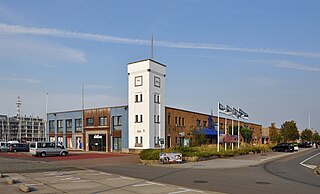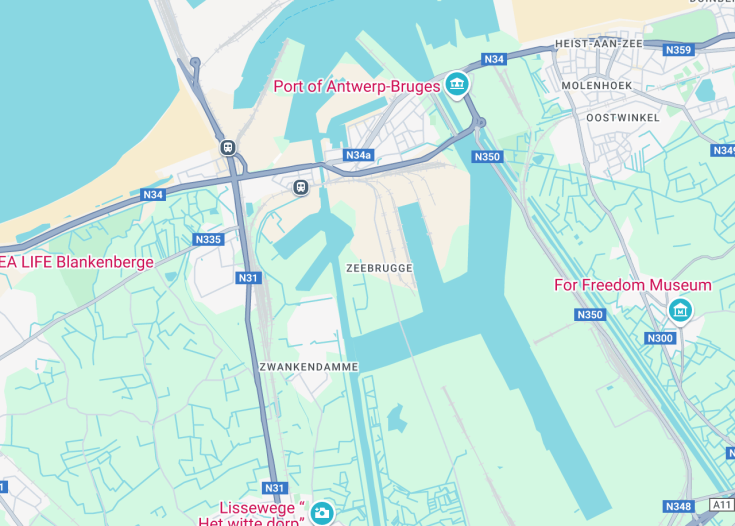Zeebrugge, a dynamic port town in Belgium, provides a unique blend of industrial might and coastal charm. Renowned for its vast marina, significant shipping operations and seafood, Zeebrugge serves as a gateway to the historic cities of Bruges and Ghent. Visitors can explore the Seafront maritime theme park, enjoy fresh mussels and shrimps directly from local fishermen, or stroll along the tranquil beaches. Serving both as a commercial hub and a cultural destination, Zeebrugge offers a fascinating mix of robust industry and rich, maritime heritage.
Ensure to visit the Zeebrugge Beach during sunset for a stunning view that captures the essence of this beautiful coastal town.
Take a guided tour of the port to gain an in-depth understanding of Zeebrugge’s pivotal role in international shipping and logistics.
Top things to do & see in Zeebrugge
Select the following sights and activities to discover best tickets and tours available in Zeebrugge.
Zeebrugge: Belgium’s Coastal Gem
| Country | Belgium |
| Time in Zeebrugge | GMT+1 |
| Language spoken | Dutch |
| Population | 4,000 (World Population Review) |
| Currency | Euro (€, EUR) |
| Airports |
|
Zeebrugge, a coastal village and port in Belgium, is a region rich in history and modern dynamism. This small town plays a significant role in Europe’s maritime industry and serves as a gateway to the exploration of Belgium’s cultural landscape. Known for its vast port, Zeebrugge is not just Belgium’s most important fishing port but also one of the most significant ports in Europe for car and passenger traffic. The strategic location of the port enhances its significance, acting as a bridge between the United Kingdom and continental Europe.
The history of Zeebrugge is intertwined with maritime tales and the dramatic sweep of world events, including its role in both World Wars. Its port was the scene of a notable raid during World War I. The town offers a mixture of modern industry and quaint charming sights, including wide beaches and a maritime theme park which preserves the historical and nautical spirit of Zeebrugge. Today, the port’s influence extends into the economy by facilitating international trade and providing thousands of jobs, playing a crucial role in the local and national economy.
In addition to being an industrial hub, Zeebrugge is also a starting point for those looking to explore cultural landmarks and enjoy the gastronomy of Belgium, being particularly renowned for its seafood. With initiatives to boost sustainable development and tourism, Zeebrugge is poised to maintain and grow its position as an influential port city while preserving its natural beauty and historical heritage.
Where is Zeebrugge?
Zeebrugge is located along the coast in the province of West Flanders, Belgium, strategically nested on the North Sea coast.
Distances:
| Route | Distance by car | Time by car |
|---|---|---|
| Brussels to Zeebrugge | 71 miles (114 km) | 1 hour 10 minutes |
| Antwerp to Zeebrugge | 66 miles (106 km) | 1 hour 15 minutes |
| Ghent to Zeebrugge | 32 miles (51 km) | 40 minutes |
What is Zeebrugge famous for?
Zeebrugge is famed for its large port, significant both as a commercial and fishing harbor. It’s also known for its historical importance with strategic roles during the World Wars.
History
Prehistory to Middle Ages
The area now known as Zeebrugge has roots stretching back to prehistoric times, with evidence of Roman and later Merovingian activity in the region. However, it wasn’t until the medieval period that Zeebrugge began to emerge as a point of interest due to its strategic coastal position. During this era, the settlement served primarily as a fishing village, leveraging its proximity to the bountiful North Sea.
16th to 18th Century
Over the centuries, Zeebrugge’s importance grew modestly, largely remaining under the radar of major historical events. It was during the reign of the Spanish Netherlands and later under Austrian rule that the village began to see a slow but steady growth. The construction of small piers and increased fishing activity marked this period.
19th Century to World War I
The true transformation of Zeebrugge began in the 19th century when Belgium gained independence. The new Belgian government focused on improving maritime infrastructure, leading to the construction of the Bruges-Zeebrugge Canal in 1905. This canal linked Zeebrugge directly to one of Belgium’s historical hearts, Bruges, significantly boosting its maritime prominence. However, the village’s strategic importance also made it a target during World War I, where it served as a German submarine base. After the war, efforts were made to rebuild and expand the port further.
World War II to Present
World War II again saw Zeebrugge playing a strategic role due to its port facilities, suffering considerable damage. Post-war reconstruction included significant modernization and expansion of the port, which transformed Zeebrugge into one of Europe’s leading ports, specializing in container transport as well as being a major ferry hub. Today, the port is integral to Belgium’s economy and continues to expand, adding advanced technological infrastructures to enhance its logistic capabilities.
Visit Zeebrugge
What to see and do in Zeebrugge
Zeebrugge, with its deep-rooted maritime heritage and modern vibrancy, offers a variety of attractions for visitors. The foremost among these is undoubtedly the Port of Zeebrugge, where you can take a guided port tour to witness its bustling activities.
The Seafront Maritime Theme Park provides an interactive insight into marine life and nautical adventures, perfect for families. For a peaceful retreat, the sandy beach at Zeebrugge presents a serene getaway. History enthusiasts may visit the Zeebrugge Church and the nearby World War I and II memorials that recount the region’s poignant past.
Festivals and events in Zeebrugge
Zeebrugge hosts a myriad of events reflecting its rich culture and maritime legacy. Notable among them is the annual Seafood Festival, which happens in spring, celebrating the town’s fishing heritage. Summer ushers in the Zeebrugge Beach Festival, a popular music event attracting visitors from across Europe. Lastly, the winter months are brightened by the Christmas Market at Zeebrugge, which provides festive cheer with its array of local crafts and foods.
Best time to visit Zeebrugge
The best time to visit Zeebrugge is between late spring and early autumn when the weather is most favorable for exploring the outdoors and partaking in local events. This period offers an optimal climate for enjoying both the cultural festivities and the natural beauty of the seaside.
Is Zeebrugge worth visiting?
Zeebrugge is undeniably worth visiting for those intrigued by maritime history and modern port dynamics, coupled with the charm of peaceful beaches and vibrant local culture. Whether it’s exploring one of Europe’s largest ports, relishing in the tranquility of sandy shores, or delving into the historical narratives of past wars, Zeebrugge offers a unique blend of attractions that cater to a wide array of interests.










